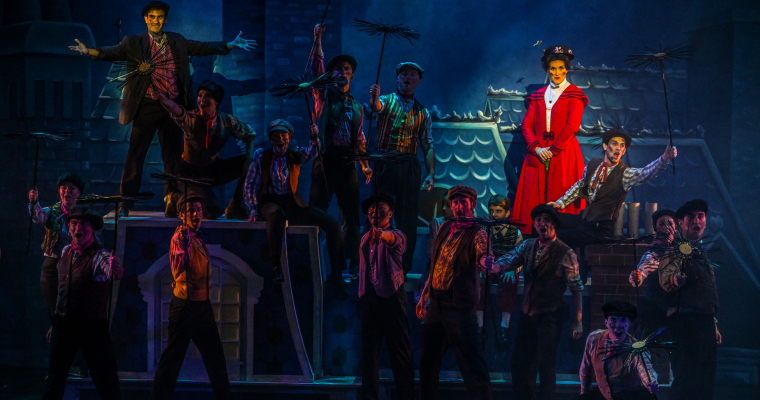
Lighting highlights the titular character in this scene from featuring chimney sweeps from Slow Burn Theatre Company's production of "Mary Poppins." (Photo by Larry Marano)
Every once in a while, at the theater, you blink back tears following a show. Such tears may come from a reservoir of feelings that include joy for having experienced a first-rate production and sadness because you did not want it to end.
Slow Burn Theatre Company’s mounting of “Mary Poppins,” which is practically perfect in every way, is one such production.
From the energetic and invigorating showstoppers to the heartfelt and touching moments toward the end, this production has earned its mid-show standing ovations and sold-out audiences.
True, it runs through Sunday, April 9, so time remains to see the show. But you would be wise not to waste a second before inquiring about tickets. As Poppins would say "spit spot"!
With a cast of 32, big sets, large production numbers, and extravagant period costumes, “Mary Poppins” is the professional, non-profit and award-winning Slow Burn’s largest production yet. And it is among its best.
When Melissa Whitworth, as the title character, flies, she glides through the air like a graceful bird before landing without a hitch. Such smoothness is an apt metaphor for Slow Burn’s production. It all unfolds seamlessly with hardly a hiccup.
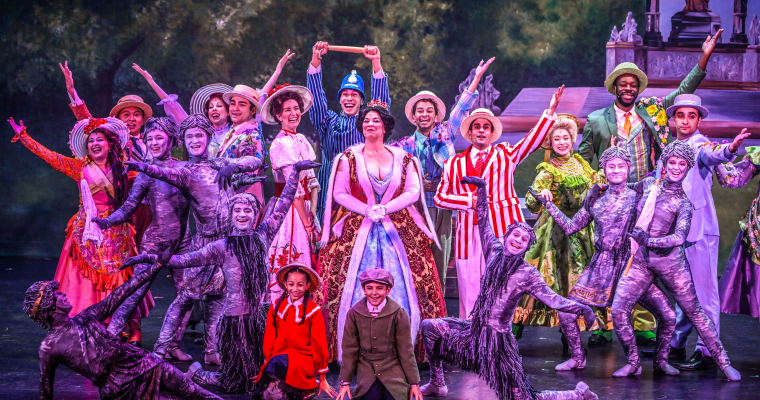
Colorful period costumes are one of the eye-popping standouts in Slow Burn's production of "Mary Poppins." (Photo by Larry Marano)
Credit director Patrick Fitzwater, Slow Burn’s artistic director, for making it all appear effortless. In fact, Fitzwater’s direction is invisible, and when that is the case, a director has done his or her job. Also, we must praise the cast and behind-the-scenes artists for working as one to execute Fitzwater’s vision. After all, successful live theater requires effective collaboration, and this company of actors and behind-the-scenes artists apparently work well as a team.
As anybody who has seen the show knows, “Mary Poppins” offers audiences an irresistible visual feast. Indeed, from magical moments to colorful sets and costumes, there is plenty of eye candy to go around.
Fortunately, Slow Burn’s production offers pleasing visuals without sacrificing sincere emotional moments. For instance, when Michael Banks tells the titular character that he loves her, it sounds genuine. Also, when George Banks (Matthew W. Korinko) speaks gently to his children toward the end, he sounds genuinely happy and thankful that he has children.
Many people may remember “Mary Poppins” for its memorable songs and the title character’s flight. However, at its heart, this beloved classic tale is about a family, particularly a father, discovering what is truly important in life – loved ones, not money and material possessions.
The stage musical is not a direct adaptation of the 1964 film starring Julie Andrews and Dick van Dyke. Rather, the Tony-nominated Broadway musical features elements of the movie and the original children’s books by P.L. Travers, as well as updated material.
The stage musical, unlike the film, places more emphasis on the Banks children’s naughtiness and their parents’ dysfunctionality. Also, the funny and touching live show deepens the character of George Banks. In particular, we learn about his past, which may help to explain why he treats his children the way he does.
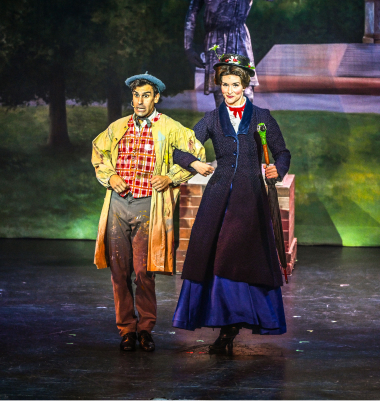
Adam T. Biner portrays Bert while Melissa Whitworth steps into the title role as Mary Poppins in Slow Burn Theatre's production at the Broward Center. (Photo by Larry Marano)
For those unfamiliar with “Mary Poppins,” it takes place around 1910 in England and centers on the Banks family. Tension exists between husband-and-wife George and Winifred Banks, while their children, Jane and Michael, are naughty, mouthy, and verbally fight with each other.
The family’s last name is appropriate and may be symbolic; George works at a bank and he considers his job to be the most important thing in his life. Further, he believes that when it comes to rearing children, discipline and order should reign. That is how Ms. Andrew, his disciplinarian nanny, raised him and he has adopted that method for raising Jane and Michael. The problem is that method has not proven successful; the children are naughty, hyper, and have caused many nannies to leave. But after the titular character arrives, things slowly begin to change for the better.
The character who undergoes the biggest change is George. He starts out as a stern, formal, and joyless man. But by the end, he has transformed into a happy, energetic man who appreciates his family. Korinko as George makes us see and hear the sensitive soul behind George’s gruffness.
He makes his character’s transformation happen gradually, almost unnoticeably. At first, Korkino, an actor with dark hair, dark eyes, and a mustache, lowers his eyebrows, and speaks in a sharp voice. He lends George polish, but also a formality, and a commanding, no-nonsense demeanor. Further, he speaks to his children with more than a hint of exasperation and impatience in his voice and manner.
In addition, palpable tension exists between George and his wife, Winifred. April Strelinger portrays her as an obedient, loving, and devoted wife and mother, but also a conflicted woman searching for her place in life.
By contrast, Poppins seems assured of her role in life. Specifically, she is a mysterious nanny who brings happiness to troubled households before literally flying off for her next assignment.
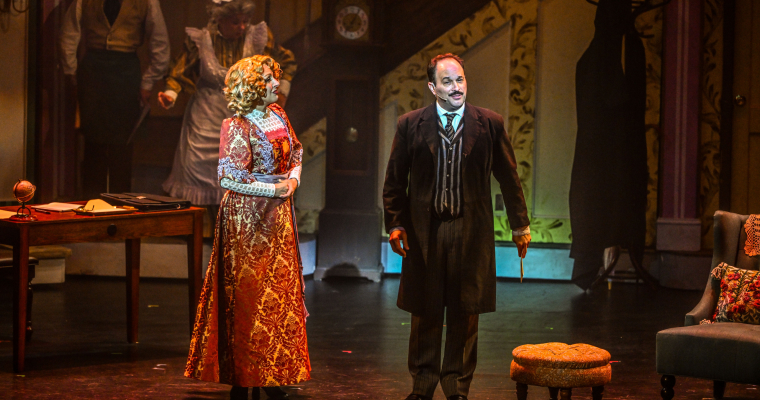
Matthew W. Korinko as George Banks, right, and April Strelinger as Winfred, in Slow Burn Theatre's "Mary Poppins." (Photo by Larry Marano)
Whitworth imbues the nanny with charm and confidence without making her seem arrogant. Rather, she conveys the kind of calm assurance that would put anybody at ease and make us believe that, indeed, anything can happen if you let it. Whitworth’s Mary Poppins stands upright, speaks clearly, and quietly commands attention without calling attention to herself.
When Whitworth sings, she does so in a clear, pleasant, and expressive voice. The performer seems to have particular fun with the song, “Supercalifragilisticexpialidocious.” Unlike in the film, she and other characters don’t just sing the song. In addition, they spell out the nonsensical word vocally and with their hands while they sing. This talented group of actors sing the number and spell out the word as though it were part of their regular vocabulary. They imbue the number with the necessary energy, making it a showstopper to which you want to clap and sing along.
Ditto for the song “Step in Time.” That number, as well as other scenes, feature physical choreography staged by Ashley Rubin. The choreography includes tapping, spins, leaps, jumps, and somersaults, all of which the performers execute as naturally as breathing.
Speaking of movement, Adam T. Biner proves to be a nimble Bert. He is a mysterious character who is a jack of all trades, narrates the show, and somehow knows the titular nanny. With dark and wide shining eyes and an aura of mystery and drama, Biner’s Bert never fails to captivate. Biner also nails a cockney accent, while the rest of the cast sing and speak convincingly in a regular British accent.
While it is not the same as live music, the pre-recorded tracks that accompany the actors when they sing sound rich enough without drowning out the performers.
On any afternoon or night, you will see two of four child actors portraying Jane and Michael Banks. They alternate in the roles. During the reviewed performance, Nate Colton portrayed Michael, while Victoria Vasquez played Jane. The other actors are Spencer Hanan and Stella Anne Macey.
Colton and Vasquez are assertive and mischievous in their roles. To their credit, they remain in character throughout and avoid cuteness. By the end, these young performers radiate joy and peacefulness as a more mature Jane and Michael.
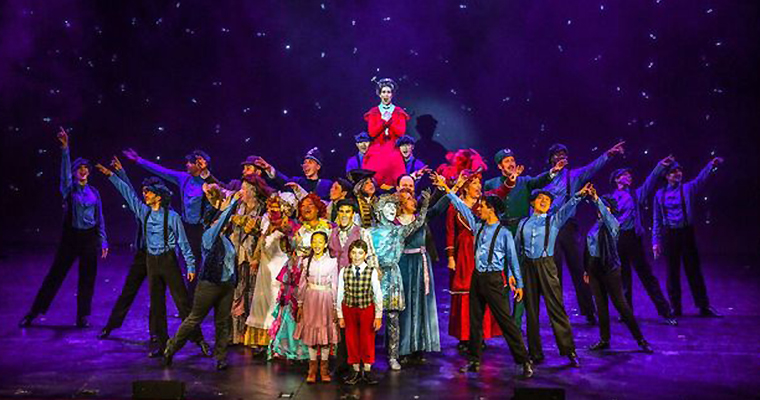
Lighting highlights the titular character in this striking stage picture (Photo by Larry Marano)
Meanwhile, a stark contrast exists between Whitworth’s loveable title character and Heather Jane Rolff’s Miss Andrew. Rolff is formidable in the role of Mr. Banks’ former nanny, and demonstrates an ability to sing high notes clearly. Also, Rolff reveals an ability to growl while singing “Brimstone and Treacle.” The song’s title refers to the type of medicine that Miss Andrew, who does not appear in the film, shoves down the mouths of children to make them behave.
As Miss Andrew and the title character practically do battle, an undeniable tension exists between “Brimstone and Treacle” and a “Spoon full of Sugar.” They represent contrasting methods of rearing children. One is harsh, while the other gently yet firmly entices youngsters. In fact, "Mary Poppins" may leave you pondering which method works better.
The show is largely an escapist, humorous piece that makes us all kids again. Who among us cannot use magic, memorable music, and laughter to make us forget about our troubled world for a couple of hours?
The actors perform on appealing, appropriately bright, and sturdy-looking sets that roll or drop onto the stage and off quickly, allowing for smooth transitions between scenes. And lighting designer Clifford Spulock deftly creates an aura of nonrealism with his multi-colored lighting. Spulock also highlights actors, sets appropriate moods with his lighting, and uses colors wisely with an attention to detail In fact, the lights, combined with thick stage fog, reinforce a sense of mystery and fantasy. We also see what resembles a starry night sky toward the end, perfectly capturing the mood.
In addition to directing, Fitzwater designed the sound, allowing us to understand just about every word that the performers utter.
Before the show started on Thursday night, Fitzwater noted that performances have regularly sold out with enthusiastic audience members. Further, he thanked parents for introducing their children to live theater by bringing them to the show. The youngsters represent the “next generation of theatergoers,” he said.
One such child sat next to me. From his seat, he danced along with the actors and waved to them. It’s a safe bet that he thoroughly enjoyed his night out at the theater and here's hoping he becomes a regular theatergoer.
Disney’s and Cameron Macintosh’s “Mary Poppins,” presented by Slow Burn Theatre Company, runs through Sunday, April 9 at the Amaturo Theater in the Broward Center for the Performing Arts. The address is 201 S.W. 5th Ave. in Ft. Lauderdale. Performance times are 7:30 p.m. Wednesday through Saturday, and 1 p.m. Saturday and Sunday. The running time is about two hours and 20 minutes including a 20-minute intermission. Tickets range from $49 to $67. Call (954) 462-0222 for tickets. Also, www.browardcenter.org or www.slowburntheatre.org.




